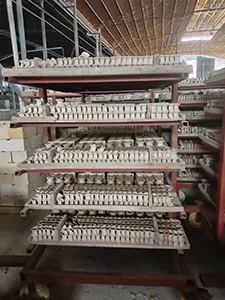The pressure drop of Intalox saddle packing refers to the resistance encountered by fluid streams as they pass through the packed bed in industrial columns, a key parameter that balances energy efficiency and separation performance. Measured in units such as Pascals per meter (Pa/m) or millimeters of water column per meter (mmH₂O/m), it varies based on packing size, material, fluid properties, and operational conditions, making it a central consideration in process design.

Intalox saddle packing typically exhibits a pressure drop range of 50 to 500 Pa/m under standard operating conditions, with specific values depending on packing size. Smaller packings (16mm–25mm) generally create higher pressure drops, ranging from 200 to 500 Pa/m, due to their higher specific surface area and more compact arrangement. Larger sizes (50mm–76mm) result in lower pressure drops, typically 50 to 200 Pa/m, as their larger void spaces reduce flow resistance for both gas and liquid phases.
Fluid flow rates significantly influence the pressure drop of Intalox saddle packing. As gas or liquid velocity increases, the pressure drop rises exponentially due to increased friction and turbulence within the packed bed. This relationship follows empirical correlations, such as the Ergun equation, which relates pressure drop to superficial velocity, fluid density, viscosity, and packing properties like specific surface area and void fraction. For example, doubling gas velocity in a column with 25mm Intalox saddles can increase pressure drop by a factor of three or more.

The physical properties of the fluids being processed also impact pressure drop. Viscous liquids or dense gases create higher resistance, leading to increased pressure drop compared to low-viscosity fluids or light gases. In processes involving mixed-phase flow, the interaction between gas and liquid streams introduces additional pressure drop components, with liquid holdup in the packing bed reducing effective void space and increasing flow resistance.
Material type affects the pressure drop characteristics of Intalox saddle packing indirectly, primarily through surface roughness and structural uniformity. Metal and ceramic variants, with smoother surfaces, generally exhibit slightly lower pressure drops than plastic packings of the same size, as rough plastic surfaces can create minor turbulence. However, material density has minimal impact on pressure drop, as the primary resistance comes from the packing’s geometric structure rather than its weight.
Packing bed height is a cumulative factor in pressure drop calculations. Total pressure drop across the column equals the pressure drop per unit height multiplied by the packed bed height. For example, a 5-meter bed of 38mm Intalox saddle packing with a pressure drop of 150 Pa/m would result in a total pressure drop of 750 Pa. This cumulative effect necessitates careful consideration in tall columns, where excessive pressure drop can require larger pumps or compressors, increasing energy costs.
Intalox saddle packing’s unique geometry—combining saddle curves and open channels—minimizes pressure drop compared to other random packings like raschig rings or Berl saddles. The symmetric design promotes streamlined flow, reducing eddy formation and dead zones that would otherwise increase resistance. This geometric advantage makes Intalox saddles a preferred choice for processes where energy efficiency is prioritized, such as large-scale distillation plants.
Pressure drop optimization often involves balancing packing size and operational parameters. For high-flow applications, larger Intalox saddle packings with lower specific surface areas reduce pressure drop but may sacrifice some mass transfer efficiency. Engineers mitigate this by adjusting liquid distribution systems or operating at optimal velocity ranges to maintain separation performance while controlling pressure drop.
In industrial practice, pressure drop is measured using differential pressure gauges installed at the top and bottom of the packed bed, providing real-time data to monitor system performance. Deviations from expected pressure drop values can indicate issues like packing fouling, channeling, or liquid loading, enabling proactive maintenance to restore efficiency.
In summary, the pressure drop of Intalox saddle packing is a dynamic parameter influenced by packing size, flow rates, fluid properties, and bed height. Its typical range of 50 to 500 Pa/m, combined with the packing’s geometric efficiency, allows for balanced design in industrial separation processes, ensuring both effective mass transfer and energy-efficient operation.

